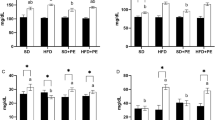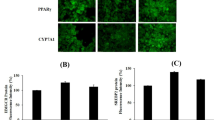Abstract
Purpose
Studies have found that pomegranate juice (PJ) consumption increases the binding of high-density lipoproteins (HDL) to paraoxonase 1 (PON1), thus increasing the catalytic activity of this enzyme. PON1 is an antioxidant arylesterase synthesized in the liver and transported in plasma in association with HDL. Decreased levels of PON1 are associated with higher levels of cholesterol. We determined the effects of PJ on body weight, cholesterol, and triacylglycerols through 5 months of supplementation. In addition, the effect of PJ on pon1 gene expression in the liver was also measured by RT-qPCR as well as the activity in serum by a semiautomated method using paraoxon as a substrate.
Methods
CD-1 mice were either fed a control diet or were fed a high-fat diet 1.25% (wt/wt) cholesterol, 0.5% (wt/wt) sodium cholate, and 15% (wt/wt) saturated fat. 300 μL of PJ containing 0.35 mmol total polyphenols was administered by oral gavage to half of the high fat mice daily. The rest of the high fat mice and the control mice were administered with 300 μL of water.
Results
PJ-supplemented animals had significantly higher levels of expression of pon1 compared to the unsupplemented group. PJ-supplemented animals had twice the PON1 activity of the unsupplemented group. In addition, PJ-supplemented animals had the lowest body weight and significantly reduced cholesterol and triacylglycerol levels, although the tricylglycerol levels were not consistently decreased.
Conclusions
These results suggest that PJ protects against the effects of a high-fat diet in body weight, and cholesterol levels.






Similar content being viewed by others
References
Jurenka J (2008) Therapeutic applications of pomegranate (Punica granatum L.): a review. Altern Med Rev 13:128–144
Lansky EP, Newman RA (2007) Punica granatum (pomegranate) and its potential for prevention and treatment of inflammation and cancer. J Ethnopharmacol 109:177–206
Aviram M, Dornfeld L, Kaplan M, Coleman R et al (2002) Pomegranate juice flavonoids inhibit LDL oxidation and cardiovascular disease: studies in atherosclerotic mice and in humans. Drugs Exp Clin Res 28:49–62
Borowczyk K, Shih DM, Jakubowski H (2012) Metabolism and neurotoxicity of homocysteine thiolactone in mice: evidence for a protective role of paraoxonase 1. J Alzheimers Dis 30:225–231
Rosenblat M, Hayek T, Aviram M (2006) Anti-oxidative effects of pomegranate juice (PJ) consumption by diabetic patients on serum and on macrophages. Atherosclerosis 187:363–371
Mertens-Talcott SU, Jilma-Stohlawetz P, Rios J, Hingorani L, Derendorf H (2006) Absorption, metabolism, and antioxidant effects of pomegranate (Punica granatum L.) polyphenols after ingestion of a standardized extract in healthy human volunteers. J Agric Food Chem 54:8956–8961
Seeram NP, Aviram M, Zhang Y, Henning SM et al (2008) Comparison of antioxidant potency of commonly consumed polyphenol-rich beverages in the United States. J Agric Food Chem 56:1415–1422
Gil MI, Tomás-Barberán FA, Hess-Pierce B, Holcroft DM, Kader AA (2000) Antioxidant activity of pomegranate juice and its relationship with phenolic composition and processing. J Agric Food Chem 48:4581–4589
Seeram NP, Lee R, Heber D (2004) Bioavailability of ellagic acid in human plasma after consumption of ellagitannins from pomegranate (Punica granatum L.) juice. Clin Chim Acta 348:63–68
Mackness B, Durrington P, McElduff P, Yarnell J et al (2003) Low paraoxonase activity predicts coronary events in the Caerphilly prospective study. Circulation 107:2775–2779
Basu A, Penugonda K (2009) Pomegranate juice: a heart-healthy fruit juice. Nutr Rev 67:49–56
Lacinski M, Skorupski W, Cieslinski A, Sokolowska J et al (2004) Determinants of homocysteine-thiolactonase activity of the paraoxonase-1 (PON1) protein in humans. Cell Mol Biol (Noisy-le-grand) 50: 885–893
Domagala TB, Lacinski M, Trzeciak WH, Mackness B et al (2006) The correlation of homocysteine-thiolactonase activity of the paraoxonase (PON1) protein with coronary heart disease status. Cell Mol Biol (Noisy-le-grand) 52: 4–10
Rozenberg O, Rosenblat M, Coleman R, Shih DM, Aviram M (2003) Paraoxonase (PON1) deficiency is associated with increased macrophage oxidative stress: studies in PON1-knockout mice. Free Radic Biol Med 34:774–784
Tward A, Xia YR, Wang XP, Shi YS et al (2002) Decreased atherosclerotic lesion formation in human serum paraoxonase transgenic mice. Circulation 106:484–490
Gaidukov L, Tawfik DS (2005) High affinity, stability, and lactonase activity of serum paraoxonase PON1 anchored on HDL with ApoA-I. Biochemistry 44:11843–11854
Rosenblat M, Aviram M (2009) Paraoxonases role in the prevention of cardiovascular diseases. Biofactors 35:98–104
Jakubowski H (2010) The role of paraoxonase 1 in the detoxification of homocysteine thiolactone. Adv Exp Med Biol 660:113–127
Jakubowski H (2000) Calcium-dependent human serum homocysteine thiolactone hydrolase A. Protective mechanism against protein N-homocysteinylation. J Biol Chem 275:3957–3962
Khateeb J, Gantman A, Kreitenberg AJ, Aviram M, Fuhrman B (2010) Paraoxonase 1 (PON1) expression in hepatocytes is upregulated by pomegranate polyphenols: a role for PPAR-γ pathway. Atherosclerosis 208:119–125
Leckey LC, Garige M, Varatharajalu R, Gong M et al (2010) Quercetin and ethanol attenuate the progression of atherosclerotic plaques with concomitant up regulation of paraoxonase1 (PON1) gene expression and PON1 activity in LDLR–/– mice. Alcohol Clin Exp Res 34:1535–1542
Gouédard C, Barouki R, Morel Y (2004) Dietary polyphenols increase paraoxonase 1 gene expression by an aryl hydrocarbon receptor-dependent mechanism. Mol Cell Biol 24:5209–5222
Betanzos-Cabrera G, Guerrero-Solano JA, Martínez-Pérez MM, Calderón-Ramos ZG et al (2011) Pomegranate juice increases levels of paraoxonase1 (PON1) expression and enzymatic activity in streptozotocin-induced diabetic mice fed with a high-fat diet. Food Res Int 44:1381–1385
Shimada M, Ishibashi S, Inaba T, Yagyu H et al (1996) Suppression of diet-induced atherosclerosis in low density lipoprotein receptor knockout mice overexpressing lipoprotein lipase. Proc Natl Acad Sci USA 93:7242–7246
Kaplan M, Hayek T, Raz A, Coleman R et al (2001) Pomegranate juice supplementation to atherosclerotic mice reduces macrophage lipid peroxidation, cellular cholesterol accumulation and development of atherosclerosis. J Nutr 131:2082–2089
Furlong CE, Richter RJ, Seidel SL, Motulsky AG (1988) Role of genetic polymorphism of human plasma paraoxonase/arylesterase in hydrolysis of the insecticide metabolites chlorpyrifos oxon and paraoxon. Am J Hum Genet 43:230–238
Charlton-Menys V, Liu Y, Durrington PN (2006) Semiautomated method for determination of serum paraoxonase activity using paraoxon as substrate. Clin Chem 52:453–457
Lei F, Zhang XN, Wang W, Xing DM et al (2007) Evidence of anti-obesity effects of the pomegranate leaf extract in high-fat diet induced obese mice. Int J Obes (Lond) 31: 1023–1029
de Nigris F, Balestrieri ML, Williams-Ignarro S, D’Armiento FP et al (2007) The influence of pomegranate fruit extract in comparison to regular pomegranate juice and seed oil on nitric oxide and arterial function in obese Zucker rats. Nitric Oxide 17:50–54
Aviram M, Volkova N, Coleman R, Dreher M et al (2008) Pomegranate phenolics from the peels, arils, and flowers are antiatherogenic: studies in vivo in atherosclerotic apolipoprotein E-deficient [E 0] mice and in vitro in cultured macrophages and lipoproteins. J Agric Food Chem 56:1148–1157
Al-Muammar MN, Khan F (2012) Obesity: the preventive role of the pomegranate (Punica granatum). Nutrition 28:595–604
Lowe ME (1994) Pancreatic triglyceride lipase and colipase: insights into dietary fat digestion. Gastroenterology 107:1524–1536
Bagri P, Ali M, Aeri V, Bhowmik M, Sultana S (2009) Antidiabetic effect of Punica granatum flowers: Effect on hyperlipidemia, pancreatic cells lipid peroxidation and antioxidant enzymes in experimental diabetes. Food Chem Toxicol 47:50–54
Huang TH, Peng G, Kota BP, Li GQ et al (2005) Pomegranate flower improves cardiac lipid metabolism in a diabetic rat model: role of lowering circulating lipids. Br J Pharmacol 145:767–774
Xu KZY, Zhu C, Kim MS, Yamahara J et al (2009) Pomegranate flower ameliorates fatty liver in an animal model of type 2 diabetes and obesity. J Ethnopharmacol 123:280–287
Shih DM, Gu L, Hama S, Xia YR et al (1996) Genetic-dietary regulation of serum paraoxonase expression and its role in atherogenesis in a mouse model. J Clin Invest 97:1630–1639
Vitalone A, Cole TB, Furlong CE (2005) Modulation of paraoxonase (PON1) activity. Biochem Pharmacol 69:541–555
Shih DM, Gu L, Xia YR, Navab M et al (1998) Mice lacking serum paraoxonase are susceptible to organophosphate toxicity and atherosclerosis. Nature 394:284–287
Rock W, Rosenblat M, Miller-Lotan R, Levy AP et al (2008) Consumption of wonderful variety pomegranate juice and extract by diabetic patients increases paraoxonase 1 association with high-density lipoprotein and stimulates its catalytic activities. J Agric Food Chem 56:8704−8713
Acknowledgements
Financial support for this work was provided by CONACyT Problemas Nacionales PDCPN2013-01 and PAI 2015 UAEH. Juan C. Cancino-Díaz is a fellow from COFAA-IPN, EDI-IPN, and SNI-CONACYT. We also thank Fernanda Resendiz and Rodrigo Ronces for his assistance in editing this work.
Author information
Authors and Affiliations
Corresponding author
Ethics declarations
Conflict of interest
The authors declare they have no conflict of interests regarding the publication of this paper.
Rights and permissions
About this article
Cite this article
Estrada-Luna, D., Martínez-Hinojosa, E., Cancino-Diaz, J.C. et al. Daily supplementation with fresh pomegranate juice increases paraoxonase 1 expression and activity in mice fed a high-fat diet. Eur J Nutr 57, 383–389 (2018). https://doi.org/10.1007/s00394-017-1394-2
Received:
Accepted:
Published:
Issue Date:
DOI: https://doi.org/10.1007/s00394-017-1394-2




